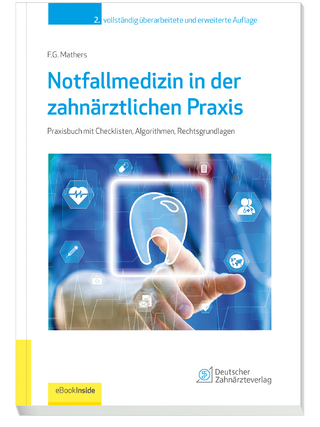
The Foundations of Emergency Care
Open University Press (Verlag)
978-0-335-22125-7 (ISBN)
- Titel ist leider vergriffen;
keine Neuauflage - Artikel merken
Tim Barr, Cardiff University, UKThe Foundations of Emergency Care is an accessible text that brings together both academic and clinical experts to combine coverage of the clinical skills and underpinning theoretical knowledge essential to practice within the modern emergency setting.Using an evidenced-based and protocol driven approach, this clinical companion guides readers through a multitude of common patient scenarios, to help them acquire essential skills in assessment and priority assignment in an emergency care setting. Each chapter includes scenarios that utilise common emergency care presentations to clearly demonstrate how practitioners can identify critical illness at an early stage through understanding how disease and illness affect normal physiology and how this relates to the patient’s clinical presentation. This ability to critically analyse physical findings assists the practitioner in becoming a specialist and directly saves lives.Key areas covered include:
Cardiac Emergencies: including the new 2006 ALS guidelines Head Injuries Acute Surgical Emergencies Gynaecologic and Obstetric Emergencies Respiratory Distress Paediatric Emergencies Minor Trauma and IllnessMajor TraumaAcute Medical Emergencies
The book also includes scenarios that cover the treatment of the elderly and those presenting with mental health emergencies. This important new book encourages readers to reflect on their clinical encounters to gain further insight into relevant treatment options and illustrates how critical thinking can be applied in emergency care. Essential reading for healthcare professionals working within emergency care and students requiring the fundamental skills necessary to competently undertake patient assessment and correctly prioritise patient care.
Cliff Evans has been the Emergency Department Lecturer for TVU and NW London for 3 years, teaching the Emergency BSc to all local Emergency Departments. Emma Tippins is Senior Sister for Practice Development at Chelsea and Westminster Hospital. Contributors: Michelle Stanton, Senior Lecturer at TVU Paul Newcombe, Senior Lecturer, St Georges University of London Claire Washbourne, ED Consultant Nurse (Minor injury), C&W Andrew Fraser, Emergency Consultant, Newham Hospital
Foreword and Acknowledgements
Contents
List of Scenarios
List of Tables
List of FiguresChapter 1 - Introduction to Emergency Care – Emma Tippins & Cliff Evans
Emergency Care
Applying Theory to Practice
Chapter 2 – Initial Assessment Prioritising Care Delivery – Cliff Evans
Introduction
Homeostasis
Normal Perfusion
Defining Shock
Types of Shock
Hypovolaemic Shock
Septic Shock
Anaphylactic Shock
Cardiogenic Shock
Neurogenic Shock
Initial Assessment
Chapter 3 – Acute Cardiac Emergencies – Cliff Evans
Introduction
Prevalence
Pathophysiology
Acute Coronary Syndromes
Unstable Angina
Non ST Elevated Myocardial Infarction
ST Elevated Myocardial Infarction
Initial Assessment
Assessing the ECG
ECG Recognition – The Basics
Treatment Regimens for ACS
Atrial Fibrillation
Heart Blocks Pathophysiology
Degrees of Heart Block
Cardiac Arrest Synopsis
Advanced Life Support
Chapter 4 – Minor Injuries – Claire Washbourne
Introduction
Chapter 5 - Major Trauma - Assessment Prioritisation and Initial Treatment – Andrew Frazer
Introduction
Definition
Prevalence
Organisation of Trauma Care
The ABCDE Approach to Initial Assessment
Airway (with cervical spine control)
Advanced Airway Techniques
Alternative Airway Management Techniques
Breathing (with ventilation)
Airway Obstruction
Tension Pneumothorax
Open Pneumothorax
Massive Haemothorax
Flail Chest
Cardiac Tamponade
Circulation (with haemorrhage control)
Fluid Resuscitation
The Chest
The Abdomen
Diagnostic Peritoneal Lavage
Focused Abdominal Sonography for Trauma
Computed Tomography
The Pelvis and Long BonesvBurns
Disability
Exposure/Environmental Control
Chapter 6 – Gynaecological and Obstetric Emergencies – Michelle Stanton
Introduction
Bleeding in Early and Late Pregnancy
Miscarriage
Ectopic Pregnancy
Obstetric Haemorrhage
Non-pregnant Causes of Vaginal Bleeding
Ovarian Cysts
Pelvic Inflammatory Disease
Emergency Delivery
Conclusion
Chapter 7 – Acute Surgical Emergencies – Paul Newcombe
Introduction
Patient Assessment
Appendicitis
Cholecystitis
Bowel Obstruction
Pancreatitis
Peritonitis
Renal Colic
Abdominal Aortic Aneurism
Conclusion
Chapter 8 – Head Injuries – Cliff Evans
Introduction
The Brain
Definition and Prevalence
Anatomy and Physiology
Primary Damage and Directional Forces
Secondary Damage
Types of Head Injury
The Assessment
Head Injury and Pupillary Changes
Continuing Assessment
Summary
Chapter 9 – Respiratory Emergencies – Cliff Evans & Emma Tippins
Introduction
Dyspnoea
Anatomy and Physiology
Airway Assessment and Management
Basic Airway Adjuncts
Oxygen Delivery Devices
Asthma
Chronic Obstructed Pulmonary Disease
Pneumonia
Applying Theory to Practice
Chapter 10 – Medical emergencies – Cliff Evans
Introduction
Cerebral Vascular Accident
Sickle Cell Disease
Pulmonary Embolism
Gastrointestinal Haemorrhage
Diabetes
Acute Confusional State
Hyperglycaemia
The National Service Framework for Diabetes
Diagnosis
Acute Diabetic Emergencies - Hyperglycaemia
Conclusion
Chapter 11 – Paediatric Emergencies - Jayne Gwyther
Introduction
Anatomical and Physiological Differences
Recognition of the Unwell Child Using a Rapid Assessment Process
Childhood Asthma
Meningococcal Disease
The Fitting Child
Consent and Treatment
Safeguarding Children in the ED
Conclusion
| Zusatzinfo | Illustrations |
|---|---|
| Verlagsort | Milton Keynes |
| Sprache | englisch |
| Maße | 157 x 236 mm |
| Gewicht | 622 g |
| Themenwelt | Medizin / Pharmazie ► Medizinische Fachgebiete ► Notfallmedizin |
| ISBN-10 | 0-335-22125-4 / 0335221254 |
| ISBN-13 | 978-0-335-22125-7 / 9780335221257 |
| Zustand | Neuware |
| Haben Sie eine Frage zum Produkt? |
aus dem Bereich


